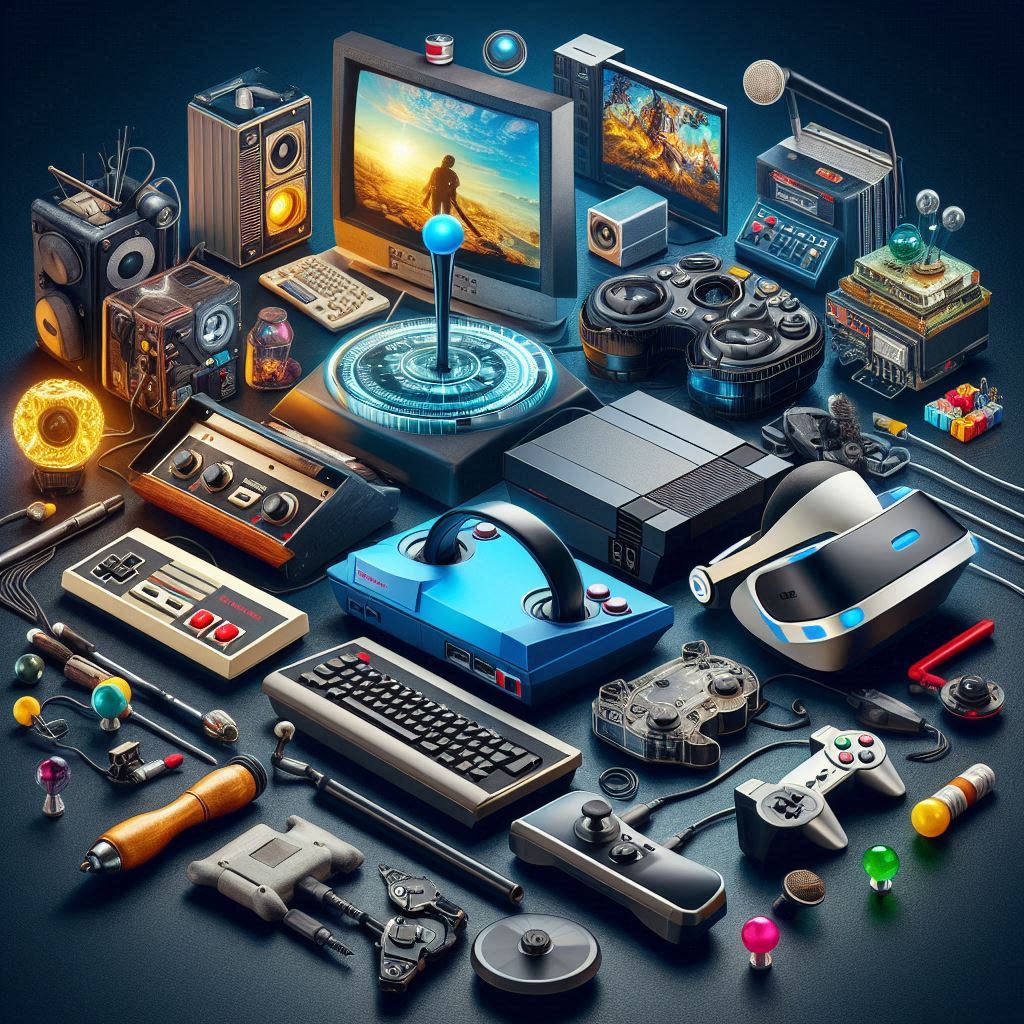Introduction
The world of gaming has undergone a remarkable transformation since its inception. From the dimly lit halls of arcade parlors to the immersive experiences offered by today’s cutting-edge technology, the evolution of gaming is a testament to human ingenuity and the relentless pursuit of entertainment. This article aims to take a comprehensive look at the best gaming technology, comparing and contrasting how far we’ve come from the early days of pixelated screens and simple mechanics to the current era characterized by photorealistic graphics and complex interactivity.
In the early days, gaming was a niche hobby, primarily enjoyed at arcades and through rudimentary home consoles. These early technologies laid the foundation for what was to come, offering the first glimpses of what digital entertainment could achieve. With the advent of handheld devices, gaming became more accessible, allowing enthusiasts to take their favorite games on the go.
As technology advanced, so did the capabilities of gaming systems. Modern gaming technology now boasts high-performance consoles that deliver unparalleled graphical fidelity, gaming PCs that offer customizable experiences, and virtual reality systems that immerse players in entirely new worlds. These advancements have not only enhanced the quality of games but have also expanded the scope of what games can be, blurring the lines between reality and virtual experiences.
Looking ahead, the future of gaming is poised to be even more revolutionary. Emerging technologies such as cloud gaming, artificial intelligence, and augmented reality promise to redefine the gaming landscape once again. These innovations are set to make games more accessible, intelligent, and interactive than ever before, ensuring that the evolution of gaming technology is far from over.
In this article, we will journey through the annals of gaming history, exploring the technological milestones that have defined each era. From the nostalgic charm of early arcade machines to the groundbreaking advancements of today and the promising trends of tomorrow, we will celebrate the best gaming technology “now and then.”
Early Gaming Technology
The evolution of gaming technology is a captivating journey that showcases human ingenuity and creativity. From the rudimentary beginnings of arcade machines to the advent of home consoles and handheld devices, each milestone has played a crucial role in shaping the gaming landscape we know today.
Arcade Machines
In the 1970s and 1980s, arcades were the epicenters of gaming culture. These bustling venues housed a variety of coin-operated machines that offered an array of experiences, from the simple yet addictive gameplay of “Pong” to the complex adventures of “Pac-Man” and “Space Invaders.” The allure of arcade machines lay in their ability to deliver instant gratification and competitive excitement. Players would line up, quarters in hand, eager to beat high scores and achieve bragging rights. The social aspect of these arcades cannot be overstated; they were communal spaces where friendships were forged and rivalries were settled.
Home Consoles
While arcade machines ignited the spark, it was home consoles that truly brought gaming into the mainstream. The release of the Magnavox Odyssey in 1972 marked the dawn of home gaming, but it was Atari’s 2600, launched in 1977, that revolutionized the industry. For the first time, families could enjoy a wide variety of games from the comfort of their living rooms. The 2600’s library included classics like “Asteroids,” “Centipede,” and “Pitfall!”—titles that became household names.
The 1980s saw fierce competition between various console manufacturers. Nintendo’s entry into the market with the Nintendo Entertainment System (NES) in 1985 was a game-changer. With iconic titles like “Super Mario Bros.” and “The Legend of Zelda,” Nintendo not only revived the struggling video game industry but also set new standards for game design and storytelling. Sega’s Genesis, released in 1989, added another dimension to the console wars, showcasing the growing diversity and innovation within the industry.
Handheld Devices
Parallel to the development of home consoles, handheld gaming devices began to emerge, offering gamers the freedom to play on the go. The late 1980s and early 1990s were a pivotal period for handheld gaming, with Nintendo once again leading the charge. The Game Boy, released in 1989, was a compact, durable device that became a global phenomenon. Its monochrome screen and simple controls were complemented by a robust library of games, including the ubiquitous “Tetris” and the beloved “Pokémon” series.
Other companies, such as Sega with its Game Gear and Atari with the Lynx, attempted to capture the handheld market but struggled to match the Game Boy’s success. The Game Boy’s dominance was attributed not only to its impressive game catalog but also to its superior battery life and portability, making it the go-to choice for gamers on the move.
Summary
The early days of gaming technology laid the groundwork for the sophisticated systems we enjoy today. Arcade machines introduced the world to the thrill of interactive entertainment, home consoles brought that excitement into our living rooms, and handheld devices ensured that gaming could be a part of our everyday lives, no matter where we were. Each of these innovations contributed to the foundation upon which modern gaming technology is built, setting the stage for the remarkable advancements that followed.
Modern Gaming Technology
The landscape of gaming technology has undergone a seismic shift in recent decades. From the pixelated simplicity of early arcade machines to the sophisticated, lifelike experiences of today, modern gaming technology encompasses a wide range of platforms and innovations. This section delves into the key components that define contemporary gaming, specifically focusing on high-performance consoles, gaming PCs, and virtual reality.
High-Performance Consoles
High-performance consoles have pushed the boundaries of what is possible in home gaming. Leading the charge are industry giants like Sony, Microsoft, and Nintendo, each offering consoles that boast exceptional graphics, processing power, and immersive gameplay experiences.
- PlayStation 5 and Xbox Series X: These next-gen consoles exemplify the pinnacle of modern gaming technology. Equipped with custom AMD processors, they deliver lightning-fast load times, ray-tracing capabilities for realistic lighting, and 4K resolution at high frame rates. Both systems also offer backward compatibility, allowing gamers to enjoy titles from previous generations.
- Nintendo Switch: While not as graphically intensive as its competitors, the Nintendo Switch has revolutionized gaming with its hybrid design. This console can seamlessly transition from a home gaming system to a portable device, making it a versatile option for gamers on the go. Its innovative Joy-Con controllers and exclusive titles like “The Legend of Zelda: Breath of the Wild” have cemented its place in modern gaming.
Gaming PCs
Gaming PCs continue to be the gold standard for those seeking the ultimate gaming experience. Unlike consoles, PCs offer unparalleled customization, allowing gamers to tailor their rigs to meet specific performance needs.
- Hardware Advancements: Modern gaming PCs are equipped with powerful GPUs from companies like NVIDIA and AMD, capable of rendering games in stunning detail. High-end CPUs and ample RAM ensure smooth multitasking and performance, while SSDs drastically reduce load times. The ability to upgrade individual components keeps gaming PCs at the cutting edge of technology.
- E-Sports and Competitive Gaming: The rise of e-sports has further fueled the demand for high-performance gaming PCs. Competitive games like “League of Legends,” “Counter-Strike: Global Offensive,” and “Fortnite” require robust systems to handle the fast-paced action and high frame rates necessary for professional play.
Virtual Reality
Virtual reality (VR) represents the frontier of immersive gaming experiences. By leveraging advanced sensors and displays, VR transports players into fully realized 3D environments, offering a level of immersion that traditional gaming cannot match.
- VR Headsets: Devices like the Oculus Rift, HTC Vive, and PlayStation VR have made significant strides in accessibility and performance. These headsets feature high-resolution displays, precise motion tracking, and ergonomic designs that enhance comfort during extended play sessions.
- Innovative Gameplay: VR has opened the door to new genres and styles of gameplay. Games like “Beat Saber,” “Half-Life: Alyx,” and “Superhot VR” utilize the unique capabilities of VR to provide experiences that are both physically engaging and deeply immersive. Developers are continually exploring new ways to harness the potential of VR, promising even more groundbreaking content in the future.
Summary
Modern gaming technology is characterized by remarkable advancements in high-performance consoles, gaming PCs, and virtual reality. These innovations have not only enhanced the visual and interactive aspects of gaming but have also expanded its reach and appeal. As we look to the future, the foundation laid by these technologies will undoubtedly pave the way for even more revolutionary developments in the gaming industry.
Future Trends in Gaming
As we stand on the cusp of a new era in gaming, the future promises to be even more transformative and immersive than the past. Emerging technologies are set to redefine what is possible, making gaming more accessible, interactive, and engaging than ever before. Here, we explore some of the most exciting future trends in gaming: cloud gaming, artificial intelligence (AI), and augmented reality (AR).
Cloud Gaming
Cloud gaming, often referred to as gaming-as-a-service, is poised to revolutionize the way we access and play video games. Unlike traditional gaming, which relies on powerful local hardware, cloud gaming allows players to stream games from remote servers. This means that even devices with limited processing power can run graphically intensive games, provided they have a stable internet connection.
Several companies have already begun to make significant strides in this area. Services like Google’s Stadia, NVIDIA’s GeForce NOW, and Microsoft’s Xbox Cloud Gaming (formerly Project xCloud) are leading the charge, offering gamers a library of titles that can be played on demand. The advantages are clear: reduced hardware costs, instant access to a vast array of games, and the potential for seamless cross-platform experiences. As internet infrastructure continues to improve globally, cloud gaming is expected to become more prevalent, making high-quality gaming universally accessible.
Artificial Intelligence
Artificial Intelligence is set to play a crucial role in the next generation of gaming. AI can enhance various aspects of game development and gameplay, offering more dynamic and responsive gaming experiences. In game development, AI can be used to create more realistic and complex environments, generate content procedurally, and even assist in debugging and optimizing game performance.
For players, AI can significantly improve non-player character (NPC) behavior, making interactions more lifelike and challenging. Adaptive AI can learn from a player’s actions, offering tailored experiences that adjust in difficulty and style according to the player’s skills and preferences. Furthermore, AI-driven analytics can provide developers with insights into player behavior, helping them to design better and more engaging games.
Augmented Reality
Augmented Reality (AR) is another technology that holds immense potential for the future of gaming. Unlike Virtual Reality (VR), which creates a completely immersive digital environment, AR overlays digital elements onto the real world. This blending of real and virtual worlds can create unique and engaging gaming experiences that are rooted in the player’s physical surroundings.
Games like Pokémon GO have already demonstrated the enormous potential of AR in gaming, offering players the opportunity to interact with virtual creatures in real-world locations. As AR technology advances, we can expect more sophisticated and immersive experiences. Wearable AR devices, such as smart glasses, could become mainstream, allowing players to interact with digital content seamlessly integrated into their everyday lives. This could open up new possibilities for location-based games, educational experiences, and social gaming interactions.
Summary
The future of gaming is bright, with cloud gaming, artificial intelligence, and augmented reality leading the charge towards more immersive and accessible experiences. As these technologies continue to evolve, they will not only enhance how we play games but also expand the horizons of what games can be. The next decade promises to be an exciting time for gamers, developers, and the industry as a whole, as we embark on this journey into the future of gaming.
Conclusion
The evolution of gaming technology from rudimentary arcade machines to sophisticated virtual reality systems is a testament to the relentless pursuit of innovation within the industry. Early gaming technology, with its pixelated graphics and simple mechanics, laid the foundational stones for an entertainment medium that has since grown into a multi-billion-dollar global phenomenon. Arcade machines, home consoles, and handheld devices of the past, despite their limitations, captivated millions and set the stage for the high-performance consoles, powerful gaming PCs, and immersive virtual reality experiences we enjoy today.
Modern gaming technology has not only enhanced the visual and auditory experience but also transformed the way we interact with games. High-performance consoles offer breathtaking graphics and seamless gameplay, while gaming PCs provide unparalleled customization and power. Virtual reality has introduced a new dimension to gaming, allowing players to step into fantastical worlds and experience games in a profoundly immersive manner.
As we look to the future, exciting trends such as cloud gaming, artificial intelligence, and augmented reality promise to further revolutionize the gaming landscape. Cloud gaming is poised to make high-quality gaming more accessible than ever, eliminating the need for expensive hardware. Artificial intelligence is set to create more dynamic and responsive game worlds, while augmented reality blurs the line between the digital and physical realms, offering unprecedented levels of interaction and engagement.
In conclusion, the journey of gaming technology is a fascinating chronicle of innovation and creativity. From the nostalgic charm of early arcade games to the cutting-edge advancements of today and tomorrow, each era has contributed its unique chapter to the story of gaming. As technology continues to advance, the future holds endless possibilities for gamers and developers alike, ensuring that the world of gaming will continue to captivate and inspire for generations to come.
<iframe width="560" height="315" src="https://www.youtube.com/embed/-htthRgQTM8?si=5Gg8a3WomCI5z0cv" title="YouTube video player" frameborder="0" allow="accelerometer; autoplay; clipboard-write; encrypted-media; gyroscope; picture-in-picture; web-share" referrerpolicy="strict-origin-when-cross-origin" allowfullscreen></iframe>




.jpg?w=100&resize=100,70&ssl=1)
